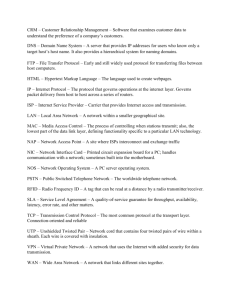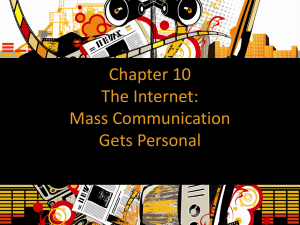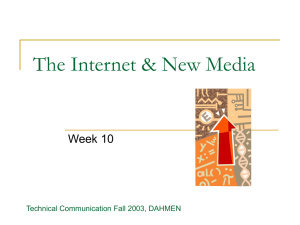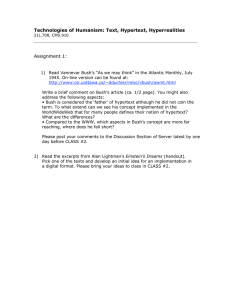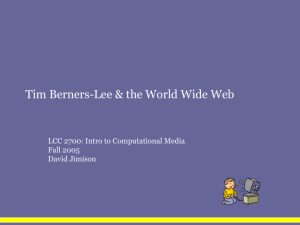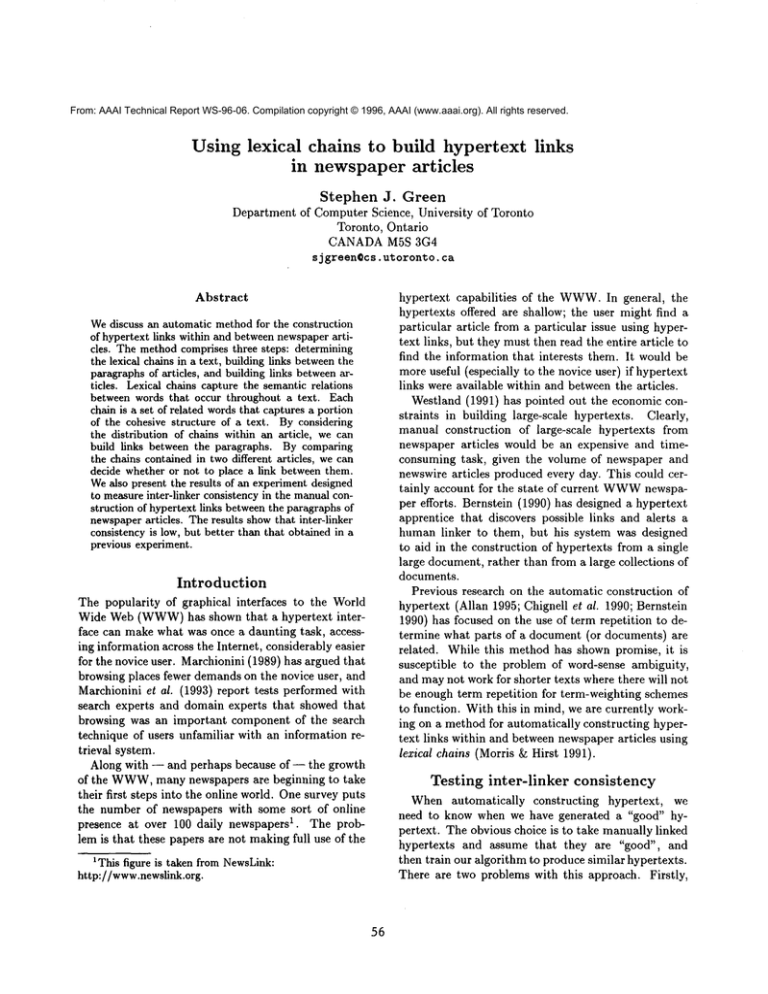
From: AAAI Technical Report WS-96-06. Compilation copyright © 1996, AAAI (www.aaai.org). All rights reserved.
Using lexical
chains to build hypertext links
in newspaper articles
Stephen
J. Green
Department of Computer Science, University of Toronto
Toronto, Ontario
CANADA M5S 3G4
sj green©cs, utoronto, ca
Abstract
Wediscuss an automatic methodfor the construction
of hypertext links within and betweennewspaperarticles. The methodcomprises three steps: determining
the lexical chains in a text, building links betweenthe
paragraphsof articles, and building links betweenarticles. Lexical chains capture the semanticrelations
between words that occur throughout a text. Each
chain is a set of related wordsthat captures a portion
of the cohesive structure of a text. By considering
the distribution of chains within an article, we can
build links between the paragraphs. By comparing
the chains containedin twodifferent articles, we can
decide whether or not to place a link between them.
Wealso present the results of an experimentdesigned
to measureinter-linker consistency in the manualconstruction of hypertext links betweenthe paragraphsof
newspaperarticles. Theresults showthat inter-linker
consistency is low, but better than that obtained in a
previous experiment.
Introduction
The popularity of graphical interfaces to the World
Wide Web(WWW)
has shown that a hypertext interface can make what was once a daunting task, accessing information across the Internet, considerably easier
for the novice user. Marchionini (1989) has argued that
browsing places fewer demandson the novice user, and
Marchionini et al. (1993) report tests performed with
search experts and domain experts that showed that
browsing was an important component of the search
technique of users unfamiliar with an information retrieval system.
Along with -- and perhaps because of-- the growth
of the WWW,
many newspapers are beginning to take
their first steps into the online world. One survey puts
the number of newspapers with some sort of online
presence at over 100 daily newspapers 1. The problem is that these papers are not makingfull use of the
I This figure is taken from NewsLink:
http://www.newslink.org.
56
hypertext capabilities
of the WWW.
In general, the
hypertexts offered are shallow; the user might find a
particular article from a particular issue using hypertext links, but they must then read the entire article to
find the information that interests them. It would be
more useful (especially to the novice user) if hypertext
links were available within and between the articles.
Westland (1991) has pointed out the economic constraints in building large-scale hypertexts. Clearly,
manual construction of large-scale hypertexts from
newspaper articles would be an expensive and timeconsuming task, given the volume of newspaper and
newswire articles produced every day. This could certainly account for the state of current WWW
newspaper efforts. Bernstein (1990) has designed a hypertext
apprentice that discovers possible links and alerts a
human linker to them, but his system was designed
to aid in the construction of hypertexts from a single
large document, rather than from a large collections of
documents.
Previous research on the automatic construction of
hypertext (Allan 1995; Chignell et al. 1990; Bernstein
1990) has focused on the use of term repetition to determine what parts of a document (or documents) are
related. While this method has shown promise, it is
susceptible to the problem of word-sense ambiguity,
and maynot work for shorter texts where there will not
be enough term repetition for term-weighting schemes
to function. With this in mind, we are currently working on a method for automatically constructing hypertext links within and between newspaperarticles using
lexical chains (Morris &: Hirst 1991).
Testing
inter-linker
consistency
Whenautomatically
constructing hypertext, we
need to know when we have generated a "good" hypertext. The obvious choice is to take manually linked
hypertexts and assume that they are "good", and
then train our algorithm to produce similar hypertexts.
There are two problems with this approach. Firstly,
10
8
"gi
o 6
M.
2
0
0.1
0.2
I
0.3
0.4
0.5
0.6
0.7
Hypertextsimilarity (Dice coefficient)
I
0.8
I
0.9
I
1.0
Figure 1: Histogramof similarity frequencies for technical documents, from Ellis et al. (1994).
16
14
12
.~ 10
8
4
0
0.1
0.2
0.3
0.4
0.5
Hypertext similarity
0.6
0.7
[
o.s
I
0.9
I
1.0
(Dice coefficient)
Figure 2: Histogramof similarity frequencies for newspaperarticles,
from our replication.
tent linkers, they had five subjects manually assign
links in each of five technical documents(Ph.D. theses and journal articles). The similarity between hypertext versions was calculated using the graph representations of the hypertexts and several similarity
coefficients from the Information Retrieval literature.
Inter-linker consistency would be indicated by a high
frequency of highly similar hypertext pairs.
As Ellis et al. expected, they found that the similarities between hypertext versions of the same document
were very low and variable, indicating that inter-linker
consistency was low. In their tests, the meansimilarity across 50 documentpairs (using the Dice coefficient
of similarity 2) was 0.116. The 95%confidence interval
it is difficult to find a large number of manuallylinked documents,since this process is extremely timeconsuming. Secondly, using such hypertexts raises the
question of how good humanlinkers are. One way to
measure how humans perform at this task is to measure the consistency of several people manually linking
the same document. In this case, consistency is measured by calculating the similarity between different
hypertext versions of the same text.
This is the approach of Ellis et al. (1994a; 1994b).
Their hypothesis was that the process of assigning hypertext links in a document would be similar to the
process of assigning index terms to documents, a task
at which humansare notoriously inconsistent. This inconsistency in assigning index terms has been shown
to reduce the effectiveness of information retrieval systems that rely on these index terms.
2TheDicecoefficient for twovectors with n elementsis:
(2~(xi .yi))/(~x~ +)-’]~y~), for 1 < i < n. This is an
association coefficient whosevalue mayrange between0.0
and 1.0
In order to demonstrate that humansare inconsis-
57
Lexical chains
for this mean was (0.069, 0.163). Figure 1 shows the
frequency histogram for the similarities calculated between all 50 possible hypertext pairs. Notice that the
graph is heavily skewed towards 0, indicating a high
frequency of low similarity measures.
Lexical chains (Morris & Hirst 1991) are sequences
of semantically related words that occur throughout
a text. Generally speaking, a document will contain
many chains, each of which captures a portion of the
cohesive structure of the document. For example, the
words apple and fruit could appear in a chain together,
since apple is a type of fruit. The chains contained in
a text will tend to delineate the parts of the text that
are "about" the same thing. Morris and Hirst (1991)
showedthat the organization of the lexical chains contained in a document mirrors, in some sense, the discourse structure of that document.
The chains can be built using any lexical resource
that relates words semantically. While the original
work was done using Roger’s Thesaurus (Chapman
1992), our current chainer (St-Onge 1995) uses
WordNetdatabase (Beckwith et al. 1991). Each type
of link between WordNetsynsets is assigned a direction
of up, down, or horizontal. Upwardlinks correspond
to generalization, for example, an upward link from
apple to fruit indicates that fruit is moregeneral than
apple. Downwardlinks correspond to specialization,
for example, a link from fruit to apple would have a
downwarddirection. Horizontal links also correspond
to specialization, but in a very specific way. For example, the antonymy relation in WordNetis given a
direction of horizontal, since it specializes a word very
accurately.
Ellis et al. suggested that the experiment be repeated with shorter documents. Due to the timeconsuming nature of the task, the number of hypertexts that they were able to collect was small (five
hypertext versions of each of five documents, allowing
only 50 hypertext pairs). The nature of the documents
linked (i.e., their length and complexity) mayhave also
had an adverse effect on inter-linker consistency. This
raises the question of howlinkers wouldfare whenpresented with shorter documents that have undergone
a strict editorial process and are written with a more
regular structure.
Wetherefore replicated this experiment, using three
different newspaperarticles that were linked by 14 subjects (giving a total of 273 hypertext pairs). Our results indicate that the consistency was higher for the
newspaper articles. Figure 2 shows the frequency histogram for the similarities that were calculated from
our hypertexts, also using the Dice coefficient of similarity. In contrast to Ellis et al. ’s results, the mean
similarity across 273 document pairs in our test was
0.285, which is well outside of the confidence interval
for the mean of the first experiment. An unpaired ttest indicates that the difference in the meansfor the
two experiments is significant at the p ~ 0.01 level.
Unfortunately, the inter-linker consistency that we
observed was still low -- too low to consider using the
hand-linked articles to train our algorithm. Even if the
consistency had been higher, the production of a large
numberof articles would be entirely too costly, even
considering the fact that the articles are muchshorter.
Still, "the hand-linked articles provide useful insights
into how and why paragraphs should be related.
\\\
human,.-
- - ~ so~ ~,~ _ _ ~person
\\\\\\~
It is possible that the reason that humanshave difficulty linking paragraphs in newspaperarticles is that,
even though there are different aspects to the story, an
article is generally about a single thing. This surfacelevel similarity of the aspects of a news story may
be seen as "noise" that can distract the linkers, causing them to either place links between unrelated paragraphs or not place links between related paragraphs.
A possible followup experiment would determine how
humanswouldplace links betweenarticles. In this case,
it seemsthat the decisions as to which articles are related would be more straightforward,
and we would
therefore expect to see a greater consistency between
linkers.
Figure 3: A strong relation between words that share
a synset.
Given these types of links, three kinds of relations
are built between words:
Extra strong Extra strong relations
repetitions of the same word.
58
exist between
Strong Strong relations exist between words that are
in the same WordNetsynset (i.e., words that are
synonymous), as in figure 3. Strong relations also
exist between words that have synsets connected by
a single horizontal link (as in figure 4), or wordsthat
have synsets connected by a single IS-A or INCLUDES
relation (as in figure 5).
@
Regular A regular relation exists between two words
when there is at least one allowable path between
a synset containing the first word and a synset containing the second word in the WordNetdatabase. A
path is allowable if it is shorter than a given (small)
length and adheres to three rules:
I
private_school
school
Figure 5: A strong relation
by an IS-A relation.
1. No other direction may precede an upward link.
2. No more than one change of direction is allowed.
3. A horizontal link may be used to move from an
upward to a downwarddirection.
between words connected
Figure 6 showsthe regular relation that can be built
between apple and carrot.
IS-AI
~CLUDES
,
apple
t
carrot
Figure 6: A regular relation connecting apple and carrot.
I
I
I
t
successor
Figure 4: A strong relation
antonyms.
I
precursor
between words that are
The result of lexical chaining is a version of the
text where each word is tagged with its chain number. An example of this is shown in figure 7, which
shows the first and fifth paragraphs of a news article
about Toronto’s Police Services Board. Here, chain
numbersare indicated with superscripts. A useful side
effect of lexical chaining is that wordsare progressively
sense-disambiguated as the chaining process proceeds.
The current implementation of the lexical chaining
algorithm has a few drawbacks. Currently, words that
59
do not appear in WordNetare not included in lexical
chains, even if they are repeated, so useful information
(e.g., a chain containing all instances of a proper noun)
is lost. The chainer is also relatively slow, whichcauses
problems when one wishes to process large (in the tens
of megabytes) volumes of text. Another problem, not
related to the implementation, is that the WordNet
database is relatively unconnected,that is, it is difficult
to capture relations betweennouns and verbs, since the
noun and verb hierarchies are connected only at the top
level.
Linking
paragraphs
Wecan use the distribution of the lexical chains in an
article to build links between the paragraphs. Wedo
this by computing the density of each chain in each
paragraph. The density of chain c in paragraph p, dcp,
The police I associationl’s call 2 for Susan Eng’s ouster 3 as head2 of Metro4’s police 1 board5 is being
called an attempt6 to use a personality I conflict I to disguise 6 the unionl’s failure 1 to adequately
explain new regulations 6 the officers I don’t like.
The Metropolitan Toronto 7 Police 1 Association I has accused I Ms. Eng of conspiring with some
I to sanction 10 the chief 1, and possibly even to fireS-him, over his handling8 of
police I board members
1
6
the police job action I -- an allegation 12 Ms. Eng vehemently denies but which ChiefI McCormack
has not bothered to correct.
Figure 7: Twoportions of a text tagged with chain numbers.
for those chains that have manyelements that occur
close together.
is defined as:
dcv = wcv
%
where wcv is the number of words from chain c that
appear in paragraph p and wv is the number of content words in p. Content words are simply all those
words that are not stop words. Our stop word list currently consists of 226 words, taken from the WordNet
distribution, most of which are closed-class or highfrequency words. This density is computed for each
chain in each paragraph. The result is that each paragraph has associated with it a vector of chain densities,
one for each lexical chain.
The similarity between two paragraphs in an article
can then be computed by computing the similarity between the chain density vectors associated with them.
This similarity can be calculated using any one of 16
similarity coefficients that we have taken from Ellis
et al. (1994a). These16 similarity coefficients include
both distance coefficients (where smaller numbers indicate a greater similarity) and association coefficients
(where greater numbersindicate a greater similarity).
Although the similarity between paragraphs can be
calculated using the chain density vectors as they are
computedfrom the paragraphs of the article, this does
not take into account Morris and Hirst’s intuition that
some chains are more important (or stronger) than others. Thus, the chain density vectors can be weighted
using one of three different weighing functions:
Chain length Each element of the chain density vector is weighted by considering the total length of
the chain, that is, the total number of elements in
the chain (including term repetitions). By using this
function, we will increase the density of each chain
depending on the number of elements in the chain,
the intuition being that long chains represent major
aspects of an article, and so they should contribute
more towards the decision to link two paragraphs.
Overall density Each element of the chain density
vector is weighted by considering the density of that
chain throughout the entire article (i.e., the number
of elements of the chain divided by the total number
of content words in the document.) This function
increases the density for chains that are long with
respect to the length of the document,i.e., this is a
measurementof relative chain length.
Stairmand weighting This is a weighting function
due to Stairmand (1994) that computes a weight for
each chain in a documentby considering the distance
between successive paragraphs that contain elements
of the chain. This function will increase3 the density
3Note that we are using the term "increase" only for
simplicity’s sake. Whetherthe weightingfunction increases
or decreases the density of a particular chain dependson
whetherwe are using an association coefficient or a distance
coefficient, respectively, to calculate the similarity between
the density vectors.
6O
In addition, the vectors can be normalized to either a
unit length or a zero mean.
Oncewe have the set of (possibly weighted and normalized) chain density vectors, the second stage of
paragraph linking is to compute a similarity matrix
for the story. Each element of the matrix corresponds
to the value of the similarity function calculated for
two chain density vectors. The result of this stage is
a symmetric n × n matrix (where n is the number of
paragraphs in the article). Using this matrix we can
calculate the mean and the standard deviation of the
paragraph similarities. Given these statistics, we can
convert each similarity into a z-score. If two paragraphs are more similar than a given threshold (given
in terms of a z-score) then they can be linked. The
result is a (symmetric) adjacency matrix showing the
links between paragraphs. This adjacency matrix is
used to render an HTML
version of the hypertext for
display with any WWW
browser.
The police 1 associationl’s call 2 for Susan Eng’s ouster 3 as head2 of Metro4’s police I board5 is being
called an attempt 6 to use a personality 1 conflict 1 to disguise 6 the unionl’s failure 1 to adequately
explain newregulations 6 the officers I don’t like.
Numberof content words: 25
Chain 1:0.320 Chain 2:0.080 Chain 3:0.040 Chain 4:0.040 Chain 5:0.040 Chain 6:0.120
The Metropolitan Toronto 7 Police 1 Association 1 has accused 1 Ms. En~ of conspiring with some
I to sanction 10 the chief 1, and possibly even to fireS-him, over his handling8 of
police 1 board members
1
6
the police job action 1 -- an allegation 12 Ms. Eng vehemently denies but which Chief1 McCormack
has not bothered to correct.
Numberof content words: 26
Chain 1:0.346 Chain 5:0.038 Chain 6:0.038 Chain 7:0.038 Chain 8:0.038 Chain 10:0.038
Chain 12:0.038
Figure 8: Linking two paragraphs.
the hypertexts generated using those two sets would
be highly similar, while two sets of parameters selected
from different groups would produce dissimilar hypertexts. Wecould then choose a single set of parameters from each group and then use these representative
sets of parameters to generate hypertexts from a large
number of articles. Wealso hope to do some sort of
analysis of variance in order to determine which of the
parameters has the greatest effect on the structure of
the hypertexts produced.
For example, figure 8 shows the two paragraphs from
figure 7 with chain density information included. In
the first paragraph, there are 8 words in chain 1 and
25 content words, so dll is 0.32. Whenusing the Dice
coefficient with no weighting and no normalization to
calculate the similarity between the chain density vectors for these two paragraphs, the result is 0.837. The
average similarity for the entire article is 0.657, while
the standard deviation is 0.158. If we are using a zscore threshold of 1.0, we can say that these paragraphs
are related (The Dice coefficient is an association coefficient, so larger numbersindicate a greater similarity.)
Clearly, the choice of a specific set of parameters (a
similarity coefficient, a weighting function, a normalization function, and a z-score threshold) will produce
different sets of paragraph links. If we allow, say, 11
different z-score thresholds, then with four weighting
functions 4, three normalization functions, and 16 similarity coefficients, we can generate 4 x3x 16× 11 - 2112
not necessarily distinct hypertexts. Our current work
is focused on reducing this space of possible hypertexts
to a set of representative hypertexts. Using a method
similar to the one in the experiment described above,
we can compute the pairwise similarity between all of
the hypertext versions of an article. If we do this for
a reasonable number of articles, we will then have a
large set of hypertext pair similarities, whereeach hypertext in a pair was generated using a different set of
parameters.
The next step is to cluster these sets of parameters
into five or six groups. The result wouldbe that if we
choose two sets of parameters from the same group,
Linking articles
While it is useful to be able to build links within articles, for a large scale hypertext links also need to be
placed between articles. For each document that is
chained, the lexical chainer outputs all of the chains
found in the document. Given this kind of output, we
can place a link between two articles by determining
how links could be built between the chains contained
in the two articles. In essence, this wouldbe a kind of
cross-document chaining.
Whenchaining across documents, we would restrict
the chaining algorithm so that only extra strong and
strong relations are allowed. Weenforce such a restriction because allowing regular relations would introduce
too many spurious connections. This will also ensure
that building the chains across documentswill be much
faster than building them within documents, since we
will avoid the cost of path-finding in WordNet.Along
with the restriction on the types of relations between
words, we will need to ensure that there is a certain
minimumnumber of links between the chains before
we can say that they are related.
Werequire multiple connections so that word sense
ambiguity does not lead us to place a link where there
4Thethree functions described earlier and no weighting
function.
61
Document
One
"ChainB I
rChalnA I
-police,association,
union,
call, head,
issue,complex,
personality,
conflict,
officer,
mentality,
anger,mater,
police
chief,failure,action,
calls,fact,racism,
individual,
titans,complexity, resignation,
topic,need,
chairwoman,
membership,
attitude,antagonism
boardmember
rChalnC I
i~Chain
DI
I~clash,
protest,
dispute,
attempt,
disguise,
services,
regulations,
looking
at, show, I handling,
goveming
drawing,
job,part,wear,
i
discussion,
situation,demand, ;
answers,
questioning,
number,
refusal,airin~l
¯
r ChainA I
"ChainC I
action,protest,
regulation,
campaign,
charges,
support,
objection
police
officer,police,
chief,
)olicechief,force,
order,
chairwoman,
association,
solicitor
general,
officer,
superintendent,
deputy,
,,concern,
~ChainB I
end,job,meet,change,
meeting,
union
premier,
queen
.....
"ChainD I
service,
activity,
head,
call,
wear,badges,
writing,issuing,
offences,
violations,
number,
routine,
turns,duty,speeding,
report,situation,
step-down,
resignation
,,
DocumentTwo
Figure 9: Links between the chains of two documents.
tition, this method would be better able to cope with a
change in language usage across different newspapers.
should not be one. Consider the following case: suppose that we allow two chains from two different documents to be related on the strength of only one link.
It is possible that two chains that contain the word
bank, for example, could be related, even though one
chain uses bank in the "financial" sense, and one uses
it in the "river" sense. Furthermore, consider the case
where we have the word union in two different
articles. Even if both articles use the word in the "labour
movement" sense, one article
may be about the police
union, while the other is about the auto workers union.
If we require multiple connections, then we avoid this
problem, because the probability
that multiple words
are co-ambiguous is quite small.
This approach is similar to the local/global
criteria for document similarity proposed by Salton et al.
(1993) for use in passage retrieval systems, although
the disambiguation is a natural side-effect of the lexical chaining process.
Evaluation
Clearly, there is a need for evaluation when building
systems such as the one that we are proposing, and so
we intend to perform a large-scale evaluation of our hypertext generation methodology. The evaluation will
take the form of a question-answering
task that will
be performed
over the WWW.We choose the WWW
because this is where current on-line newspaper efforts
are taking place and because it provides a system that
potential subjects are familiar with. The database for
these tests will be a large volume of newspaper articles,
on the order of an entire year of one newspaper.
We have decided to use a question answering task
because this is the type of task that is best done using
the browsing methodology that hypertext
embodies.
We explicitly
make no claims that our hypertext would
be useful for all information access tasks, as this is
clearly not the case. Our evaluation system will require
a standard IR system (such as SMART)to retrieve
articles to be used as starting points for browsing.
The evaluation will be designed to elicit information about the various representative
hypertexts that
we can generate. That is, we hope to determine which
set of parameters is most useful for question answering tasks. In this case, a "good" hypertext is one that
supports browsing for question answering. This question answering task will also provide information on
the usefulness of intra- versus inter-article
links.
We also hope to gather information about the sur-
Consider the illustration
in figure 9. Here we see a
portion of the chains contained in two different documents that are part of a continuing story about the
Toronto Police Services Board. Clearly, chain A from
document one and chain A from document two are related. The relations between the other chains are less
obvious. Although there is some term repetition
(e.g.
protest appears in chain D of document one and chain
C of document two), it accounts for only a few of the
connections between the chains.
Of course, this method could easily be used to link
articles from different papers. Because we are looking
for semantic relatedness, rather than strict term repe-
62
face characteristics of the hypertexts that we generate. Namely, we hope to determine whether subjects
perform better when the intra-article link anchors are
placed in the text of a paragraph, as opposed to the
end of the paragraph. Similarly, we hope to determine
whetherinter-article links are better placed in the text
or at the end of the articles.
Each subject will be provided with two questions to
answer from a small pool of questions. Here we will
adopt the methodology of Rada and Murphy (1992).
In their experiments on searcher behaviour they used
two kinds of questions: search questions and browse
questions. A search question is one whose answer is
contained in a single document, while the answer to
a browse question may be spread across several documents. In our evaluation, we would assign each subject
a search question and a browse question. Each subject
will also be assigned a set of parameters for hypertext
generation, along with a link anchoring strategy. We
will be able measure their performance in terms of time
to complete the search, links followed in searching, and
whether they retrieve the correct paragraphs to answer
the queries. Wehope that by providing the experiment
over the WWW
that we will be able to have a large
number of subjects.
Obviously, we will need to compare the results of
using our hypertext generation methodology to other
generation methodologies, most notably, that of Allan
(1995).
Conclusions
and
future
While other automatic hypertext
generation
methodologies have been proposed, many of them rely
on term repetition to build links within and between
documents. If there is no term repetition, there are
no links. This is especially a problem when attempting to build intra-document links in shorter documents
when an author may have been striving to avoid using
the same word again and again and so chose a related
word. Weavoid this problem (to some extent) by using lexical chains, which collect words based on their
semantic similarity. Our results to date have shown
promise for the methodology, and work is continuing.
Acknowledgments
The author wishes to thank Graeme Hirst and the
anonymousreferees for their commentson earlier versions of this paper. This research was supported in
part by the Natural Sciences and Engineering Research
Council.
References
Allan, J. 1995. Automatic hypertext construction.
Ph.D. Dissertation, Cornell University.
Beckwith, R.; Fellbaum, C.; Gross, D.; and Miller,
G.A. 1991. WordNet: A lexical database organized
on psycholinguistic principles. In Zernik, U., ed., Lexical acquisition: Exploiting on-line resources to build
a lexicon. Lawrence Erlbaum Associates. 211-231.
Bernstein, M. 1990. An apprentice that discovers hypertext links. In Streitz, N.; Rizk, A.; and Andre, J.,
eds., Hypertext: Concepts, systems and applications:
Proceedings of the Europeanconference on hypertext,
212-223. Cambridge University Press.
work
There are many unanswered questions in our work.
One of the most obvious is: where should the intraarticle links be anchored? Weare currently experimenting with placing the anchors at the end of each
paragraph, but we are considering whether they would
be more effective when embeddedin the text.
One of the advantages of Allah’S work (1995) is that
the links between portions of two texts can be given
a type that reflects what sort of link is about to be
followed. Wecurrently have no method for producing
such typed links, but it maybe the case that the relations between words from WordNet can be used to
determine the type of somelinks.
It is still not clear howmuchof our methodologydepends on the structure of the newspaper articles that
we are processing. Does this standard structure enhance our hypertext linking capabilities, or wouldthe
method perform equally well, given any well-written
text to work with? Weintend to see how well the
method performs on other types of texts, possibly
changing our methodology to cope with the loss of
somestructure.
Chapman,R. L., ed. 1992. Roger’s International Thesaurus. HarperCollins, 5th edition.
Chignell, M. H.; Nordhausen, B.; Valdez, J. F.; and
Waterworth, J. A. 1990. Project HEFTI: Hypertext
Extraction From Text Incrementally. Technical report, Institute of SystemsScience.
Ellis, D.; Furner-Hines, J.; and Willett, P. 1994a. The
creation of hypertext linkages in full-text documents:
Parts I and II. Technical Report RDD/G/142,British
Library Research and Development Department.
Ellis, D.; Furner-Hines, J.; and WiUett, P. 1994b. On
the creation of hypertext links in full-text documents:
Measurementof inter-linker consistency. The Journal
of Documentation 50(2):67-98.
Marchionini, G.; Dwiggins, S.; Katz, A.; and Lin,
X. 1993. Information seeking in full-text end-useroriented search systems: The roles of domain and
63
search expertise. Library and Information Science
Research15( 1 ):35-69.
Marchionini, G. 1989. Making the transition from
print to electronic encyclopedia: Adaptation of mental models. International journal of man-machine
studies 30(6):591-618.
Morris, J., and Hirst, G. 1991. Lexical cohesion
computed by thesaural relations as an indicator of
the structure of text. Computational Linguistics
17(1):21-48.
Rada, R., and Murphy, C. 1992. Searching versus
browsing in hypertext. Hypermedia4(1): 1-30.
Salton, G.; Allan, J.; and Buckley, C. 1993. Approaches to passage retrieval in full text information
systems. In Proceedings of sixteenth annual international ACMSIGIR conference on research and development in information retreival, 49-58.
St-Onge, D.
1995. Detecting and correcting
malapropisms with lexical chains. Master’s thesis,
University of Toronto. Published as technical report
CSRI-319,available at:
ftp://ftp.cs.toronto.edu/pub/reports/csri/319/
319.ps.Z.
Stairmand, M. 1994. Lexical chains, WordNet and
information retrieval. Condensedversion of Master’s
Thesis.
Westland, J. C. 1991. Economicconstraints in hypertext. Journal of the AmericanSociety for Information
Science 42(3):178-184.

